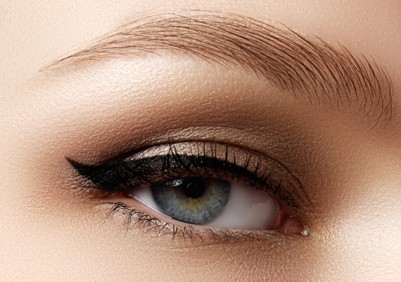Facial Plastic Surgery in Greenwich, CT Oculoplastic Surgery in Greenwich, CT
Conveniently located for Fairfield County & Westchester patients

In addition to plastic surgery,
Dr. Elsa Raskin has special training in ophthalmology and oculoplastics, making her uniquely qualified to perform
oculoplastic surgery at her
Greenwich, CT, practice. This procedure utilizes plastic surgery techniques to repair eyelids, tear ducts, and bones around the eyes. Ptosis, also referred to as a saggy eyelid, and excess tearing are common disorders that Dr. Raskin can treat with this procedure in order to improve vision and reduce eye irritation. In addition to the restorative benefits, this procedure offers, oculoplastic surgery can improve the aesthetics of your appearance by addressing drooping eyelids that can make you appear older than you are. Dr. Raskin’s training and experience in ophthalmology and cosmetic plastic surgery make her a safe choice for these complicated treatments. She trained in general surgery at New York University and ophthalmology at New York Eye and Ear Infirmary. She completed two plastic surgery fellowships, as well as an oculoplastic fellowship at the University of Pennsylvania.
What is Oculoplastics?
Oculoplastics involves surgery to the tear ducts, eyelids, and tissues and bones surrounding the eye. This procedure can address common concerns such as:
- Ptosis (droopy upper or lower eyelid)
- Obstructed vision from excess eyelid skin
- Fine lines and wrinkles around the eye
- Inward or outward turning eyelids
- Excess tearing from blocked tear ducts
- Growths on the eyelid or eye
Common Oculoplastic Procedures
Any oculoplastic procedure can be performed under local or general anesthesia to improve your vision and the aesthetics of your eyes. Common oculoplastic procedures include:
- Blepharoplasty: During this cosmetic procedure, Dr. Raskin can remove excess skin and tissue from the upper and lower eyelids to eliminate fine lines and wrinkles, droopy eyelids, and swollen bags.
- Ptosis Repair: If you have a weak levator (eyelid) muscle that has prevented your eye from completely opening and has impaired your vision, Dr. Raskin can raise the eyelid and tighten the upper eyelid muscle. If there are excess skin and fat in addition to a weakened muscle, a blepharoplasty can be performed in combination with this procedure.
The length of your procedure and your recovery will depend on the type of procedure performed and how you respond to surgery. Dr. Raskin will provide you with detailed post-operative instructions and monitor your results through follow-up appointments to optimize your recovery.
Pre-Surgery Evaluation
Before undergoing oculoplastic surgery, a thorough pre-surgery evaluation is essential to ensure the safety and efficacy of the procedure. This evaluation typically includes a detailed medical history, physical examination, and specific eye tests. The goal is to identify any potential risks and plan the surgery with precision.
Advanced Surgical Techniques
In the realm of oculoplastic surgery, advanced techniques have been developed to enhance outcomes and minimize invasiveness. One such technique is the endoscopic approach, which uses small incisions and a camera to guide the surgery. This method is particularly beneficial for procedures involving the eyebrows and mid-face, reducing scarring and recovery time. Dr. Raskin’s practice utilizes these state-of-the-art techniques to provide effective, less-invasive treatment options.
Post-Surgery Care
After oculoplastic surgery, careful post-operative care is necessary to achieve optimal results. Dr. Raskin’s practice provides detailed instructions which include keeping the head elevated, applying cold compresses to reduce swelling, and using prescribed medications to prevent infection. Patients are generally advised to avoid strenuous activities and follow a tailored care regimen to support healing. Regular follow-up appointments are scheduled to monitor the recovery process and address any concerns.
Potential Complications and How They Are Managed
Like all surgical procedures, oculoplastic surgeries carry risks. Potential complications include infection, bleeding, and asymmetry. Dr. Raskin’s practice is equipped to manage these complications through early detection and intervention. Preventive measures such as intraoperative techniques and post-operative care are emphasized to minimize risks. Patients are educated about signs of complications to ensure prompt reporting and treatment.
Lifestyle Adjustments Post-Surgery
Patients undergoing oculoplastic surgery may need to make temporary lifestyle adjustments post-surgery. Dr. Raskin advises avoiding activities that raise blood pressure, such as heavy lifting or vigorous exercise, for several weeks. Exposure to sunlight should be minimized, and protective eyewear may be recommended to guard against debris and wind. These precautions help ensure smooth recovery and prevent complications.
Recovery Timeline and Milestones
Recovery from oculoplastic surgery varies depending on the specific procedure and individual patient factors. Generally, patients can expect mild to moderate swelling and bruising for the first few weeks. Dr. Raskin outlines recovery milestones, such as the resumption of normal activities, providing a clear timeline for patients to manage their recovery expectations.
Long-term Care and Follow-up
Long-term follow-up is pivotal in oculoplastic surgery to monitor the outcomes and manage any late complications. Dr. Raskin’s practice schedules regular follow-up visits to assess the surgical results and ensure patient satisfaction. These visits also allow for the management of any delayed reactions and the planning of any additional treatments if necessary.
Techniques for Minimizing Scarring
To minimize scarring, Dr. Raskin employs precise surgical techniques and advises on post-operative care that may include the use of silicone gel sheets or scar creams. Early intervention with laser
treatments can also be effective in improving scar appearance, particularly in more visible areas.
Comparison of Surgical and Non-Surgical Options
For patients not ready for surgery, Dr. Raskin’s practice offers non-surgical options for cosmetic improvement like injectables or laser treatments. These alternatives can provide temporary relief from some cosmetic concerns and can be an effective way to delay surgery.
Age-Related Considerations
Age impacts both the decision-making process and the outcomes of oculoplastic surgeries. Younger patients might have different concerns and healing capacities compared to older patients. Dr. Raskin takes age-related factors into account when planning the procedure, ensuring that the approach and techniques are tailored to maximize the benefits while minimizing risks for each age group.
Restore Your Vision and Aesthetics
If you are experiencing oculoplastic problems, Dr. Raskin is skilled and trained to provide the care you need. Call our office at 203-861-6620 or
contact us online to schedule your consultation with Dr. Raskin.
 In addition to plastic surgery, Dr. Elsa Raskin has special training in ophthalmology and oculoplastics, making her uniquely qualified to perform oculoplastic surgery at her Greenwich, CT, practice. This procedure utilizes plastic surgery techniques to repair eyelids, tear ducts, and bones around the eyes. Ptosis, also referred to as a saggy eyelid, and excess tearing are common disorders that Dr. Raskin can treat with this procedure in order to improve vision and reduce eye irritation. In addition to the restorative benefits, this procedure offers, oculoplastic surgery can improve the aesthetics of your appearance by addressing drooping eyelids that can make you appear older than you are. Dr. Raskin’s training and experience in ophthalmology and cosmetic plastic surgery make her a safe choice for these complicated treatments. She trained in general surgery at New York University and ophthalmology at New York Eye and Ear Infirmary. She completed two plastic surgery fellowships, as well as an oculoplastic fellowship at the University of Pennsylvania.
In addition to plastic surgery, Dr. Elsa Raskin has special training in ophthalmology and oculoplastics, making her uniquely qualified to perform oculoplastic surgery at her Greenwich, CT, practice. This procedure utilizes plastic surgery techniques to repair eyelids, tear ducts, and bones around the eyes. Ptosis, also referred to as a saggy eyelid, and excess tearing are common disorders that Dr. Raskin can treat with this procedure in order to improve vision and reduce eye irritation. In addition to the restorative benefits, this procedure offers, oculoplastic surgery can improve the aesthetics of your appearance by addressing drooping eyelids that can make you appear older than you are. Dr. Raskin’s training and experience in ophthalmology and cosmetic plastic surgery make her a safe choice for these complicated treatments. She trained in general surgery at New York University and ophthalmology at New York Eye and Ear Infirmary. She completed two plastic surgery fellowships, as well as an oculoplastic fellowship at the University of Pennsylvania.


